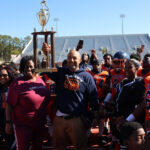While industrial design history often highlights automobiles and everyday objects, the story of designers shaping musical instruments is a fascinating, yet less explored, chapter. Just as Raymond Dietrich lent his automotive flair to Gibson’s iconic Firebird guitar, and Barnes and Reinecke modernized the Ultratone lap-steel guitar, industrial designers occasionally turned their talents to music. Robert Davol Budlong, known for his work with Zenith, collaborated with Scandalli accordions, demonstrating a trend of instrument makers seeking outside expertise to inject contemporary style and market appeal into their products. This move towards external collaborations signaled a desire to modernize, leveraging trendy aesthetics, ergonomic considerations, and emerging technologies to create fashionable, often more affordable instruments through mass production.
My research journey led me to the Archives of American Art, seeking to uncover the connection between John Vassos, a pioneering industrial designer (1898–1985), and the renowned German musical instrument manufacturer, M. Hohner. My initial interest sparked while researching instruments at the Museum of Fine Arts, Boston. John Vassos’s modernist and streamlined designs for harmonicas and accordions immediately captured my attention, recognizing their significance in both music and design history.
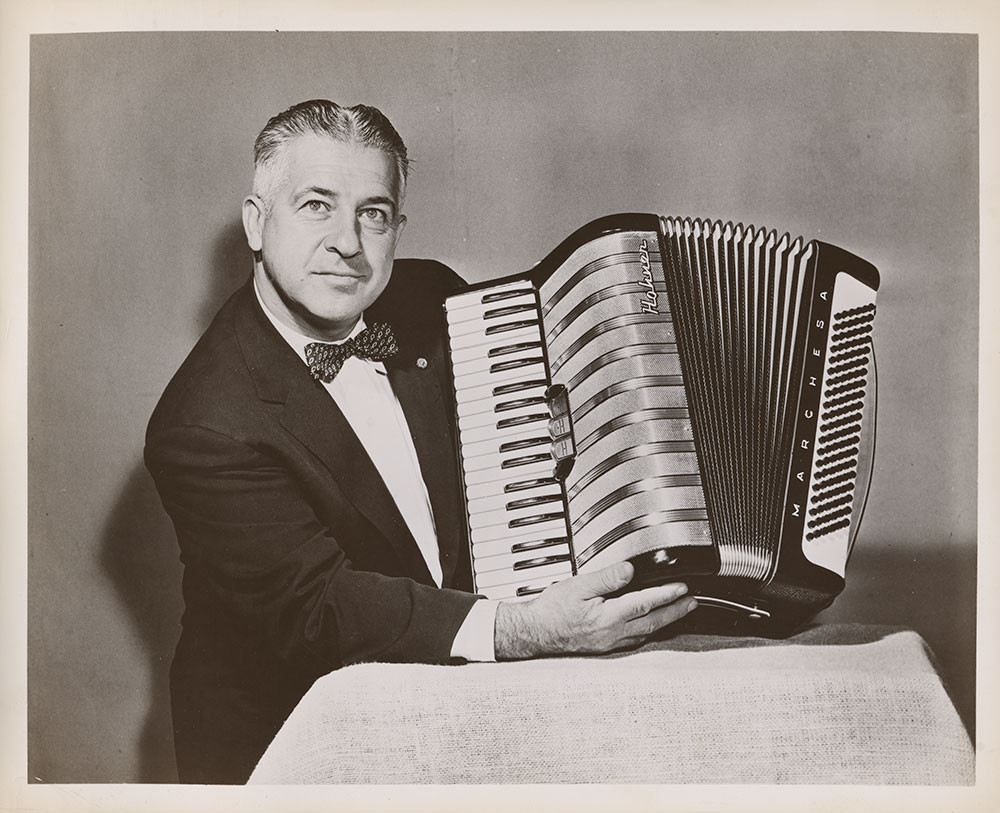 John Vassos holding the Marchesa accordion he designed for the Hohner company.
John Vassos holding the Marchesa accordion he designed for the Hohner company.
Delving into Danielle Shapiro’s insightful 2016 biography, John Vassos: Industrial Design for Modern Life, I discovered documented evidence of John Vassos’s collaboration with Hohner within his papers at the Archives of American Art. This collection, rich with drawings, technical schematics, advertisements, and correspondence, illuminated their innovative partnership and revealed numerous unmanufactured designs.
From the late 1930s and again in the late 1940s, Hohner engaged John Vassos to infuse their harmonicas and accordions with his signature modernist and streamlined aesthetic, primarily targeting the American market. Examining over forty of John Vassos’s harmonica drawings for Hohner, I was struck by their sleekness, a stark contrast to Hohner’s traditionally boxier designs. John Vassos’s sketches even incorporated dynamic lines, suggesting air movement, imbuing these instruments with a sense of speed and futuristic appeal. While Norman Bel Geddes is often credited with popularizing “streamlining,” John Vassos masterfully applied this concept to his instrument designs. However, correspondence between John Vassos and Hohner revealed post-World War II limitations. The company, still recovering, faced challenges in retooling for radical redesigns requiring new machinery and materials, leading to the shelving of some of John Vassos’s most groundbreaking concepts. Material rationing, particularly of brass for harmonica reeds, further constrained production, as detailed in Kim Field’s Harmonicas, Harps, and Heavy Breathers. Hohner’s hiring of John Vassos was set against the backdrop of post-war recovery.
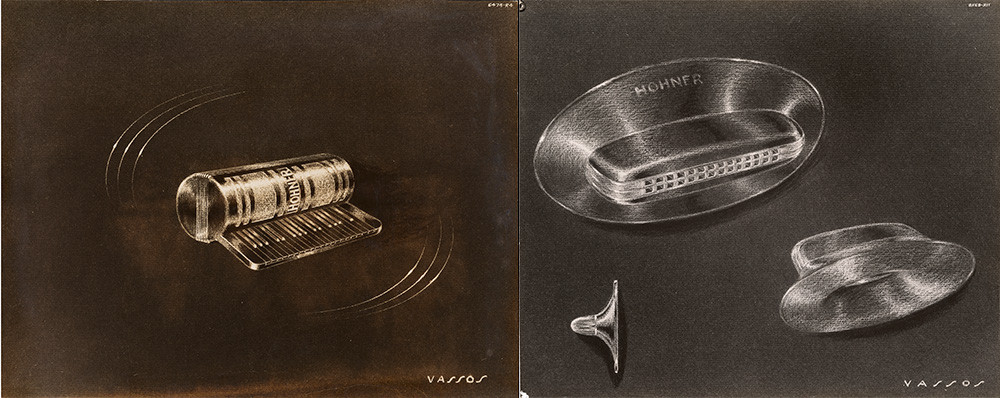 John Vassos
John Vassos
Archival materials, including correspondence and patents, reveal John Vassos’s conviction that his stylish harmonica designs improved upon the conventional rectangular form, exemplified by Hohner’s enduring Marine Band model. John Vassos introduced curved contours and vibrant, fashionable color palettes, transforming functional instruments into objects of art. Shapiro notes John Vassos’s focus on ergonomics, enhancing the user experience through design. John Vassos’s patents emphasized ergonomic improvements for easier handling and a more comfortable, curved mouthpiece. Among his designs, the Echo Elite, Regina, and Comet harmonicas achieved production and commercial availability, with the Regina and Comet also marketed under the Echo Elite brand.
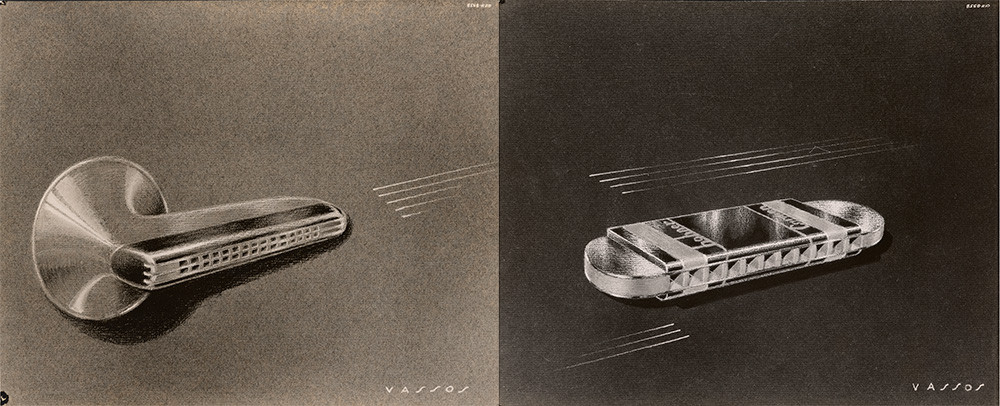 Harmonica design concept drawings by John Vassos
Harmonica design concept drawings by John Vassos
The Echo Elite harmonica, a commercially successful model by John Vassos for Hohner, featured a striking red and chrome finish, available in three sizes and various keys. This tremolo harmonica, producing a wavering sound due to slightly detuned reeds, was most popular in dual-pitch models (G and C keys), though single-sided versions also existed. Its design, with horizontal chrome lines on a red body, echoed the streamlined aesthetic of contemporary buses and trains like the General Motors’ Futureliner bus, reflecting the Art Deco influence of the era. Even the instrument case was thoughtfully designed, combining aluminum and cardboard with blue accents to enhance its sleekness. Of John Vassos’s harmonica creations, the Echo Elite resonated most strongly with consumers. The Regina followed, offered in brown, green/red, and brown/blue/red color combinations. The Comet, a teardrop-shaped harmonica patented in 1939, was produced in red, green, and blue, its name evoking the futuristic “Space Age” design sensibilities that John Vassos pioneered decades before the space race and Googie architecture movement.
 Versions of the Echo Elite harmonica made by the Hohner company and designed by John Vassos
Versions of the Echo Elite harmonica made by the Hohner company and designed by John Vassos
John Vassos extended his design philosophy to instrument packaging, considering it integral to product promotion. As Shapiro highlights, and John Vassos himself articulated, packaging was more than mere enclosure; it was a crucial aspect of the industrial designer’s role in product presentation and marketing. John Vassos often included detailed case designs in his preliminary sketches, demonstrating equal attention to the instrument and its presentation. The manufactured harmonica models featured cases that mirrored the instruments’ aesthetic, with curved lines, complementary colors, and metallic finishes, enhancing the overall product appeal.
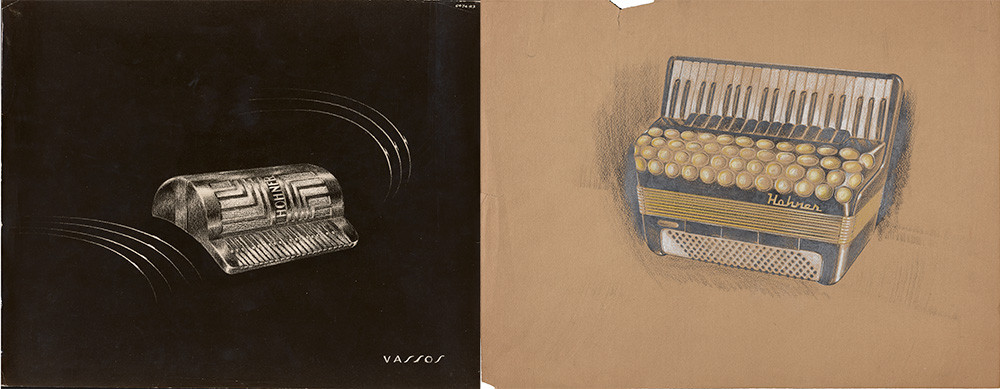 Accordion designs by John Vassos
Accordion designs by John Vassos
In 1938, John Vassos patented his groundbreaking Round model accordion for Hohner, aiming for ergonomic improvement. His innovative design curved the instrument to fit the player’s body, a departure from the boxier accordions prevalent at the time. The Hohner Museum in Trossingen, Germany, houses two 1940 prototypes of this patented design. Despite its innovation, the Round model never reached mass production, and Hohner’s records offer no clear explanation for its discontinuation.
Hohner re-engaged John Vassos in 1948 to design a new accordion line, as evidenced by archival documents detailing their business relationship. Correspondence reveals John Vassos was contracted as a consulting designer for two years at a reduced “friends and family” annual fee of $6,000. In a 1948 letter to Matthew Hohner, John Vassos emphasized his personal investment in his projects, treating them with the dedication he would his own business. Records indicate this collaboration extended well into the 1960s. John Vassos also conducted market research on Hohner and competitor products, annotating advertisements and technical drawings, particularly focusing on designs suitable for women.
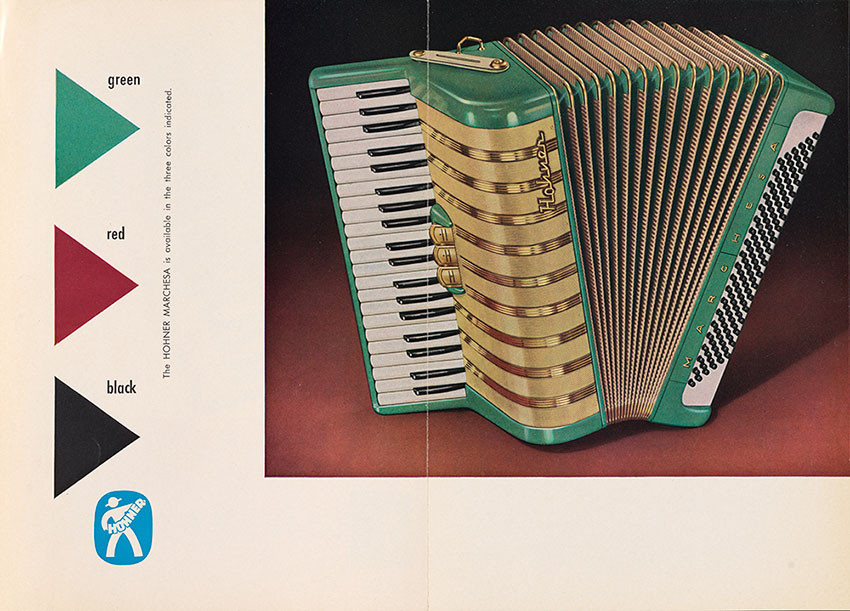 Page from brochure advertisement for the Marchesa accordion.
Page from brochure advertisement for the Marchesa accordion.
The culmination of John Vassos’s work was the Marchesa accordion, a design that took nearly eighteen months to finalize. A 1955 newspaper clipping highlighted its automotive-inspired modern colors, chosen to complement contemporary women’s fashions. Seafoam green and burgundy red options, accented with gold trim, offered a departure from traditional black and pearlized, rhinestone-studded accordions. The Marchesa aimed to appeal to American women and younger players through “simplified construction,” lighter yet stronger materials, and Hohner’s renowned technical quality. Closer examination of the Marchesa reveals narrower keyboard keys, aligning with the “ladies accordions” trend of the 1940s. While marketed as lighter, the Marchesa, at twenty-four pounds, remained comparable in weight to other accordions.
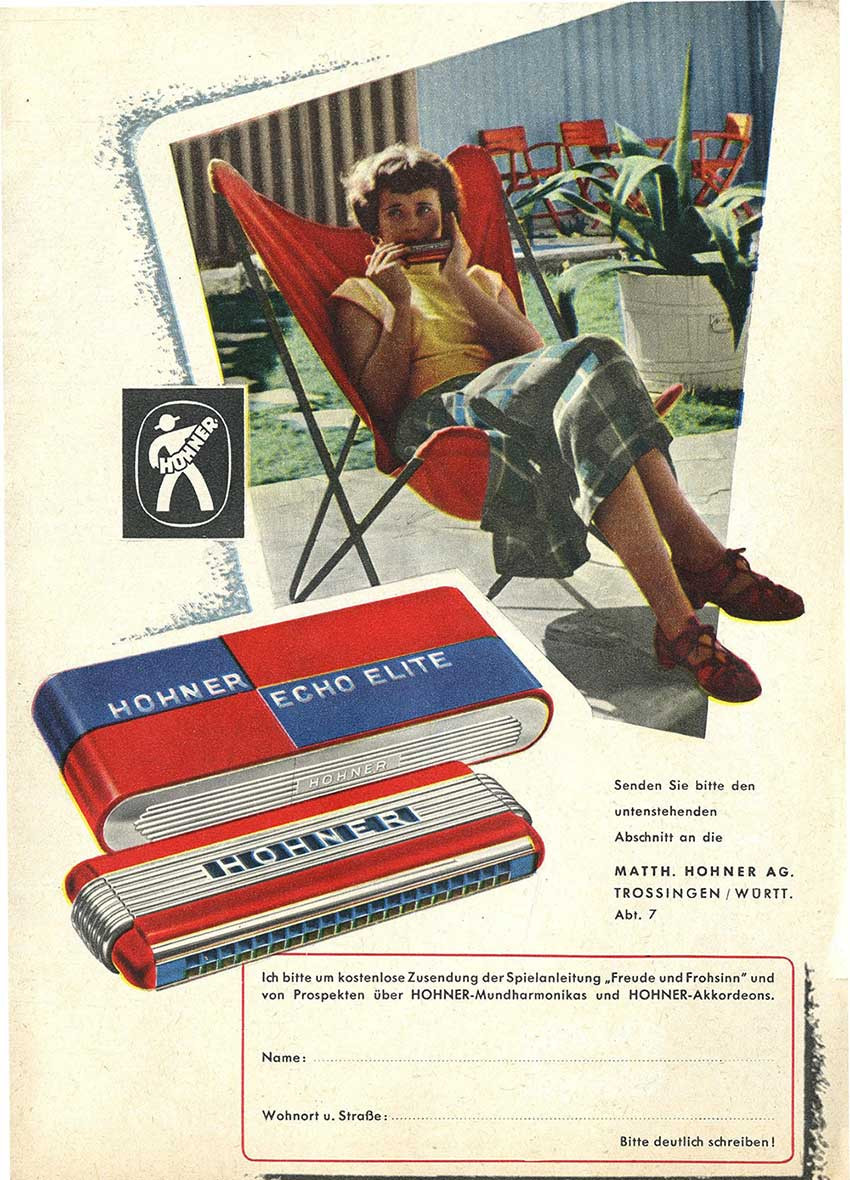 German advertisement for Echo Elite harmonica.
German advertisement for Echo Elite harmonica.
During their era, harmonicas and accordions enjoyed widespread popularity. A 1954 advertisement priced the Echo Elite harmonica between $8.50 and $12.50 (approximately $80–$120 today), competitive with similar models. The Marchesa accordion sold for $300 in 1959, equivalent to around $2,600 today. While not inexpensive, John Vassos’s designs achieved commercial traction and influenced subsequent designs from Hohner and other manufacturers. His impact is evident in later instruments featuring curved lines, chromatic buttons, and sleek chrome accents. John Vassos’s pioneering work fostered greater experimentation with shapes and color palettes within the industry. These instruments, while perhaps not always favored by professional musicians, stand as significant musical artifacts, embodying a period of design and manufacturing innovation. John Vassos’s designs continue to be recognized today, sought after by major museums as vital examples of industrial design history, solidifying John Vassos’s lasting legacy.

